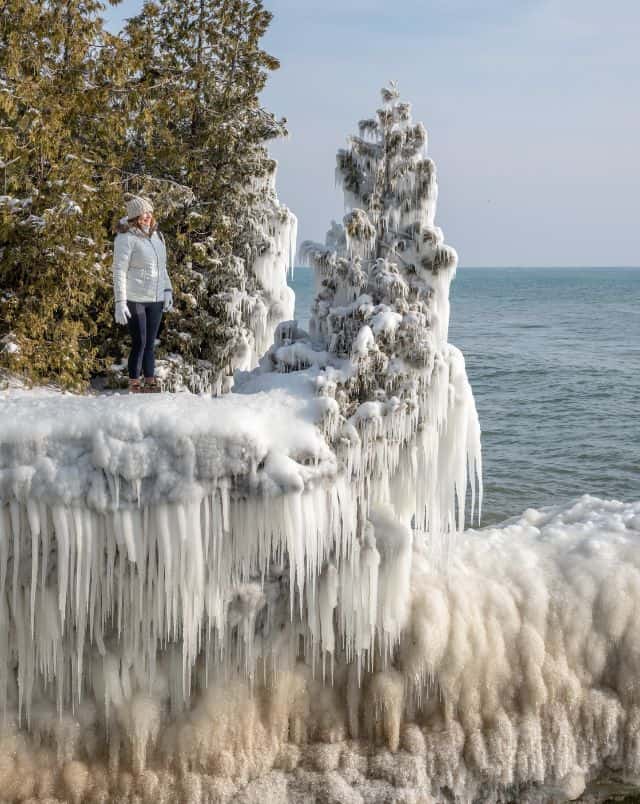Day one – Muscat to Al Mussanah
Our first full day of touring started at Wadi al Abyad, the best place in the world to see the Moho – the boundary between the earth’s crust and mantle. Here we saw a sharp contrast between the mantle rocks, consisting of a type of peridotite called hartzburgite, and the ocean crust rocks made of layered gabbro. So how is it possible to see such rocks at the surface of the earth and on land? This because in the late Cretaceous these rocks, which form part of the Semail Ophiolite, were obducted onto Arabia as an ocean basin was closed. The Semail Ophiolite is the best exposed ophiolite anywhere in the world.
We then moved onto the Gubrah Bowl this is a beautiful amphitheatre that is technically a basement core anticline, or a geological window. The upper rocks of the anticline have been eroded away leaving the older rocks exposed in the base of the bowl. After this we had a picnic lunch in Wadi Mistal. Here we observed Cretaceous coral fossils as well as deposits from a lake, that filled the wadi in the wetter, Quaternery climate. The lake was formed when a landslide dammed the wadi.
Next we saw an angular unconformity between precambrian rocks and late Permian rocks.We then moved on to Wadi Haslan where we examined Snowball Earth deposits. These deposits formed at a time when it is thought that the whole Earth was glaciated. The deposits we saw were 712ma tillites and glacial lake deposits with dropstones (rocks that fall out of icebergs) immediately overlain by tropical dolomites. These tropical dolomites are known as the cap carbonates and can be found all over the world on Snowball Earth deposits, showing when the climate warmed very rapidly at the end of Snowball Earth.
Please click on images to enlarge and to read the captions
Day Two – Al Mussanah to Sohar
Today we focused on the rocks of the upper part of the Semail Ophiolite. Our first stop was a fossilised Black Smoker (pics 2-5) which was once on the ocean floor at a spreading ridge of a back-arc basin. The smoker could be seen from several miles away as a prominent red hill, the red colour of which is due to haematite. The structure was virtually all intact, and you could imagine diving down in a submarine to see it. We saw lots of malachite, and azure copper mineralisation and epidote too. It was possible to see tube like structures (pic 3) where the hydrothermal acidic fluids would have forced their way through the rock. The site may have been lightly mined over the last 4000 years ago and the chimneys of the smoker were no longer present. Recent mining surveys have shown that a copper ore body 20m x 250m x 100m lies directly under the structure.
Our next stop was to look at basalt that had cooled just below the surface and had hexagonal cooling structures (pic 6). The weathering was occurring from the outside of the hexagons inwards. Next, we stopped for lunch at an outcrop that was 100% dykes (pic 7). This is the sheeted dyke complex that forms at spreading ridges taking magma from the magma chamber below to the surface, and is characteristic of the classic ophiolite sequence.
We then relocated to one of Oman’s most famous geosites, the incredible “Geotimes” Pillow Basalts at Wadi al Jizzi (pics 1 & 8). These are considered to be the best pillow basalt outcrops in the world. These basalts were erupted on to the seabed, and formed pillow structures as they were cooled by the sea water. Examining the pillows we were able to see their glassy outer skin, and two dykes that cut through them to feed younger basalts.
We finished the day with a visit to a copper mine (pic 9) that had been mined for most of the last 4,000 years only stopping a few decades ago leaving a great hole in the ground. This would once have been a black smoker like the one we saw earlier in the day. A few hundred metres from the mine is what may be the only ziggurat in Arabia (pic 10). A ziggurat is a stepped pyramid, and it would have been built by early copper miners who travelled to Oman from Mesopotamia.
Please click on images to enlarge and to read the captions
Day Three – Sohar to Bahla
Our first stop of the day was a fossilised white smoker (pics 2 & 3). This differed from the black smoker we saw yesterday because it was created by cooler fluids (150°C, as opposed to 300°C in the black smoker), and thus contains much less metal mineralisation, but contains lots of opaline silicate. It was possible to see hydrothermally altered pillow basalts and former feeder tubes that were completely scaled up with silicates (pic 3).
We then moved on to the site where we could see pillow basalts, feeder dykes and sills with columnar cooling structures all in the same cliff face (pic 4). It was amazing to see dykes simply coming to an end as they reached the then surface and emitted the pillow lava. This site was also the site of copper smelting 1000 years ago.
Next we stopped at the hospital in Wadi Hawasina. Here there is a fantastic view – mantle peridotites of the Semail ophiolite nappe behind us, and in front of us heavily folded marine sediments of the Hawasina nappe. The Hawasina nappe had first thrust over the Arabian continent and the Semail ophiolite nappe then thrust over both of them. The boundary between the two nappes is now thought to have been a former subduction zone, with the Semail ophiolite forming at the spreading ridge of a back arc basin. Here we saw granulite facies rocks known as the “metamorphic sole” (pic 5). These rocks would have formed in the subduction zone. Furthermore, at this contact was a hill made of marble (pic 6). This would once have been an atoll which got jammed into the subduction zone! Also at the site we saw radiolarian cherts (pic 7) that would have formed in a distal ocean basin. Soon after this stop we examined some beautiful chevron folds in the Hawasina sediments, that here appeared to be deposited by turbidites (pic 8), thus being from a proximal ocean basin. At our lunch stop we saw shallower water sediments that showed incredible boudins and moullion structures as beds had been extended and compressed again as they were forced around folds (pics 1 & 9). The final stop was a multi-coloured outcrop of Hawasina sediments in a road cut, that were also very tightly folded (pic 10).
Please click on images to enlarge and to read the captions
Day Four– Bahla to Bahla
Our first stop today was view over the ruined town of Ghul (pic 2), which lies on Cretaceous limestone, and from our viewpoint it was possible to find the a few fossils preserved in pebbles. The next site was a viewpoint of Jebel Shams, Oman’s highest peak (3,028m) and of Wadi al Nakhr (pics 3 & 4), which is also known as the “Grand Canyon of Arabia”. The cliffs of the canyon are 1,500m high in places and from our vantage point we were able to view the entire autochthonous Cretaceous and Jurassic sequence in the walls of the canyon.
We then drove via a windy mountain track to some large chevron folds near Al Hayl (pic 5). The folded rocks were late Triassic/early Jurassic in age and were part of the Hawasina nappe. The sediments appeared to be derived from turbidites but the presence of limestone, ripples and trace fossils made us think they were probably deposited on the continental slope rather than the abysmal plain.
Our picnic lunch was directly under the beautiful Jebel Misht mountain (pic 6). This mountain is made up of Triassic aged limestone and dolomite sitting on top of volcanic rock. It is known as an ‘Oman exotic’ because it was actually a submarine volcano with an atoll on top of it, which was scraped on to the continent as part of the Hawasina nappe! After lunch we stopped at the nearby Al Ayn beehive tombs World Heritage Site (pics 7 & 8). Here we not only observed the early Bronze Age tombs, but also the Hawasina sediments on which they stood. These sediments had loading structures (pic 9) and it appeared they may have been deposited in shallower continental shelf conditions.
Near the village of Sint we saw giant Triassic aged fossil bivalves (pic 1). These bivalves were up to 30cm across and belong to the extinct bivalve family Megalodontidae. They lived as semi-infaunal suspension feeders. Our final stop of the day was another archaeological one at ‘Coleman’s Rock’ (pic 10), to observe important ancient rock engravings. We then returned to Bahla for a second night.
Please click on images to enlarge and to read the captions
Day Five – Bahla to Wahiba Sands
The fifth day of our Oman tour started with a visit to the Bahla Fort World Heritage Site, (pics 2, 3 & 4) which was built between the 12th and 15th centuries by the Banu Nebhan tribe who were known for controlling the frankincense trade at the time. The fort also sits on an outcrop of ophiolitic rock and we were able to see peridotite cut by gabbro dykes (pic 4). The next stop was the Al Hoota Cave (pics 1 & 5) in the Hajar Mountains. The cave is the largest show cave in Arabia and sits in mid-Cretaceous (Albian) aged limestones and dolomites. The cave has been formed by water flowing through tectonic fractures in the rock, and contains beautiful stalactites and stalagmites. After the cave, we visited another World Heritage Site, “The Aflaj Irrigation System of Oman” (pic 6). This irrigation system is up to 4,500 years old and is seen as one of the driving forces behind the formation of Oman as a nation as it provided the reason for nomadic societies to settle down. After lunch we had a longer drive to the Wahiba Sands. En route we stopped at a site where we had a distant view of the Moho on a mountainside (pic 7), with the bulk of the mountain made of peridotite and the top capped by gabbro. We then had an exhilarating high-speed drive into the Wahiba Sand dunes to reach a desert camp where we spent the night. Before sunset we drove to the top of a nearby dune and watched the sun go down (pics 8 & 9). Here we also discussed dune formation. Our hosts at the camp then provided us with a lesson in traditional Bedouin Dance (pic 10), dinner and a talk on Bedouin life and culture by a campfire.
Please click on images to enlarge and to read the captions
Day Six– Wahiba Sands to Ras Al Jinz
Today was the penultimate day of our tour. We awoke in our desert camp in the Wahiba Sands (pic 2), and had to first navigate the dunes to reach a road again. The first stop was to see rocks of the Precambrian crystalline basement (800-1,000 million years old). Here we saw granites that formed as terranes were accreted together, cut by huge gabbro dykes (pic 3) that were intruded as the basement went through a later period of extension. All of these rocks were themselves intruded by granitic pegmatite (containing large crystals) dykes (pic 4). Our next stop was to see an ultramafic rock outcrop on the beach (pics 5 & 6), which contained volcanic fragments (lapilli) that formed due to the ascent of magma. Some authors have called the rock a kimberlite, which is the deepest mantle derived volcanic rock of all, and sometimes contains diamonds, although this outcrop contains no diamonds. Others argue this outcrop is actually a carbonatite which is also derived from deep in the mantle but less deep than kimberlite.
After our picnic lunch, we then visited one of Oman’s most famous outcrops informally known as the ‘mother of all outcrops’ (pics 1, 7 & 8). Here, red radiolarian chert is interbedded with white porcellanite. These sediments were deposited in water 4,000-4,500 metres deep, which is too deep for limestones to form, but rocks can form from radiolaria plankton because their skeletons are made of silica. Our group discussed at length why the outcrop consisted of alternating white and red layers – was it a secondary diagenetic process? Or was it directly due to cycles of sedimentation? However the sediments were deposited, they were later folded and faulted as they were thrust onto Arabia as part of the Batain Nappe (along with Oman’s other ophiolite, the Masirah Ophiolite), 15-20 ma after the emplacement of the main Semail Ophiolite. At our next stop, we saw an outcrop of manganese ore (pic 9), which contained crystals of pyrolusite (MnO2). The final stop of the day was an outcrop of carbonite volcanic rock (pic 10). The rock appeared to be a tuff (volcanic ash) rather than lava. The rock also contained beautiful veins of amethyst.


Please click on images to enlarge and to read the captions
Day Seven– Ras Al Jinz to Muscat
On the final day of our Oman geology tour, our first stop was a site 3.7m above current sea level, where marine erosion and marine organisms have carved a pitted notch into Eocene conglomerate (pic 2). This level represent the high tide level in the Eemian interglacial (127,000 to 106,000 years ago), when global temperatures were several degrees warmer than today (and, for example, hippos lived in the River Thames in the UK). Today we have already exceed Eemian CO2 levels, so this outcrop is a stark warning of what sea level rise is to come.
The following stop was a series of Miocene wave-cut platform terraces (pic 3) which are overlain by Quaternary fossil corals (pic 4). The terraces have formed due to tectonic uplift.
Next we arrived at Wadi Shab, a magnificent canyon cut into Eocene limestone, and is considered by many to be Oman’s most beautiful Wadi (pics 5 & 6). We spent two hours hiking in the wadi enjoying the wonderful scenery, we also had our picnic lunch here. We then visited a fascinating site with a tsunami deposit (pic 7) Here huge boulders could be seen on top of a cliff. Some of the boulders were even stacked up, or ‘imbricated’, showing that they had been washed into place by a giant wave! This was followed by a visit to the Bimmah Sinkhole (pic 8), which is actually a doline. The surface rock is not soluble but the layer beneath is and, when a sinkhole formed in it, the surface rock crashed through leaving a doline.
Our final stop of the tour, was at Wadi al Mayh to see the world’s largest sheath fold, which also contains many smaller isoclinal folds (pics 1&10). Sheath folds are associated with shear zones, in this case the the plate boundary along which the Semail ophiolite obducted. Normally they are only centimetre to metre in scale but this fold hinges along a 15 km long profile. Sheath folds are distinctive curvilinear folds in which the hinge actually wraps around on itself. In three-dimensions, sheath folds look much like their name implies, a sheath that might holster a sword. When eroded, the tubular-shape of a sheath fold displays a characteristic eye-shape in cross section (pic 9), and that is what can be seen on the slopes above Wadi Mayh.
Please click on images to enlarge and to read the captions
Day Eight– Departure
Our group dispersed after breakfast today, some choosing to fly straight home, others choosing to take a city tour of Muscat and others heading to nearby Dubai for a few days. What a wonderful time we had in Oman, which is an absolute paradise for geologists. Thank you to the group for good company and lively geological discussions!
We will be running this tour again in March 2021 – see our website for details: https://www.geoworldtravel.com/Oman.php
We would also like to thank Feedspot for including us in their Top 200 Travel blogs list and their Top 30 Geology blogs list





















Discussion about this post